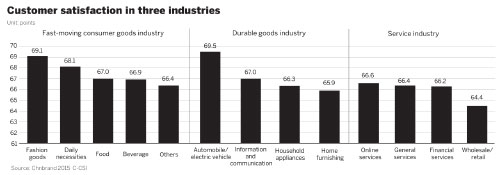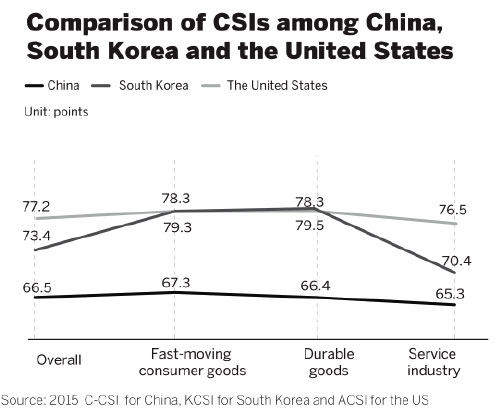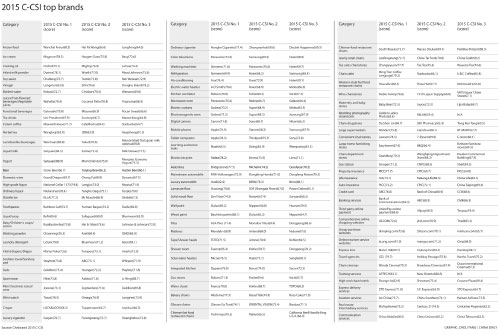C-CSI: Customer satisfaction rising in China
Among 98 surveyed sectors, Chinese brands rated highest in 70 sectors, according to Chnbrand
The 2015 China Customer Satisfaction Index, or C-CSI, has been released for the first time by Chnbrand, an institution which is considered China's most reliable brand evaluation organization.
The C-CSI is the first all-category national measurement of customer satisfaction in China. It evaluates the satisfaction of Chinese household consumers with the quality of products and services offered by both foreign and domestic companies.
The index should benefit businesses, researchers and consumers by serving as a tool for gauging the competitiveness of individual companies and predicting future profitability.
It also assesses buying behavior, helps consumers make informed purchasing decisions and helps enterprises establish their own brand management systems.
This 2015 C-CSI covers 30 cities across China and examines customer feedback from residents aged 15 to 60. Researchers collected 16,500 responses through face-to-face interviews at interviewees' homes from October 2014 to June 2015. The research covers 98 sectors, with more than 4,500 major brands surveyed.
According to the C-CSI report, the needs of customers are always changing, making it difficult for businesses to maintain their competitiveness. Businesses that can fully satisfy and possibly shape a customer's needs will be successful, it said. According to Don Peppers and Martha Rogers in their bestseller, The One to One Future, the only value a business can create comes from customers - current or potential - and it achieves success by finding, keeping and developing those customers.
Though there are many companies in China that have adopted customer satisfaction evaluations as a major measurement of company performance, the C-CSI aims to be a crucial measure for companies to follow customer preferences while promoting better services in China, according to the report.
Growing satisfaction
The general customer satisfaction score in China was 66.5 points out of a total 100 points, with the fast-moving consumer goods industry garnering 67.3 points, followed by durable goods industry with 66.4, and the service industry at 65.3.
Compared with customer satisfaction data in the United States and South Korea, Chinese companies and their services lag slightly behind.
China began research on customer satisfaction in the 1990s. Chinese companies have made efforts in improving customer satisfaction and maintaining loyalty over the past two decades with good results. Satisfaction has largely increased, especially for milk and yogurt producer Sanyuan, electric bike manufacturer Yadea Technology Group, Shangri-La Hotels and Resorts, Air China and online travel service provider eLong.com.
Among 13 sectors in the three industries, the durable goods sectors had the largest disparity between its highest and lowest scores, with automobiles and electric vehicles accounting for the highest score of 69.5. The lowest score in the durable goods sector came from home furnishings with 65.9 points.
The wholesale and retail sector had a score of 64.4, the lowest in the service industry.
Top brands by region
Among the 98 C-CSI-surveyed sectors this year, international brands rated highest in 28. Chinese brands rated highest in the 70 other sectors.
Among the top international brands, 29 percent came from the United States, 29 percent from Japan and 14 percent from Germany. Top foreign brands included Apple, Audi, AIA (life insurance), Panasonic (color television), tire producer Bridgestone, FAW-Volkswagen and Siemens, leading each sector.
Among the top 70 Chinese brands, 33 percent came from Beijing, 17 percent from Guangdong province and 10 percent from Zhejiang province. Top Chinese brands included Snow Beer, Sinopec (gas station), PICC (auto insurance), Wanda Cinema (Chain cinemas), Galanz (Electromagnetic oven), Chaoneng (washing powder) and Aux (air conditioning).
In the service industry, 91 percent of the top brands were Chinese.
Chinese brands rated highest in Internet and general services. In wholesale and retail as well as financing, more than 80 percent of the top brands were Chinese, with JD.com rating highest for its online shopping and Wumart for its supermarkets.
For the fast-moving consumer goods industry of the 2015 C-CSI, 71 percent of the top brands came from China, with the beverage sector garnering the highest number of top Chinese brands at 85 percent. Uni-President earned raves for its tea beverages and Wanglaoji garnered praise for its herbal teas. In the food sector, 67 percent of the top brands came from China, including Wanchai Ferry for its frozen foods and Chubang for its soy sauce. Magnum's ice creams and Dumex's infant milk powder rated highly.
In the durable goods sector of the 2015 C-CSI, however, the number of top international brands exceeded the number of top Chinese brands, with only 48 percent of the top brands from China. In the information and communications sector, all of the top brands were international. In the auto and electric vehicle sector, 75 percent of the top brands were foreign companies. In home furnishing items and household appliances, the number of top Chinese brands surpassed their international competitors, with Robam (kitchen exhausts and gas stoves) and Oppein (integrated kitchens) garnering high ratings.
Suggestions for improvement
The 2015 C-CSI report said many companies, though they are carrying out customer satisfaction evaluations, mostly care about evaluation scores and seldom analyze the reasons behind results.
To retain customers over the longterm, one should understand why they feel satisfied, the report said, adding that companies must understand consumers as if they were friends.
According to the report, businesses should "surprise" customers to transform their attitude from "satisfied" to "very satisfied", so as to get better result of C-CSI.
The 2015 C-CSI report suggested businesses carry out new research to discover what can "surprise" a customer and thus create satisfaction. These "surprise elements" will help businesses develop and improve products to appeal to customers' different needs.
The report said many businesses only consider the "voice of customers", - or VOC, a market research technique that collects customers' needs and wants, as a way to deal with customer complains. But, according to the report, a customer's so-called voice offers a lot more information. The report suggested companies combine the "voice" with the company's consumer database to decipher changes in customer behavior and mindset. Based on these findings, the company can devise new products and marketing strategies.
In addition, businesses should integrate solutions for customer complaints into products and services before officially launching them.
According to the C-CSI report, the ultimate goal of a customer satisfaction evaluation is to offer the most unique and tailored services for customers. The key is to move focus from "movement of truth", or MOT, to overall satisfaction.
The report suggested businesses bank on innovations to improve their services. A comprehensive plan should be devised, in which satisfaction scores are the foundation and starting point, innovation the focus, with tailored services the objective. Businesses should integrate this plan into their marketing strategies.
The C-CSI report finally suggested that companies establish management systems for customer satisfaction, in which input from all departments of a company is heeded.
For more information, visit www.chn-brand.org or contact 86-10-6225-0811. The publication of graphics and charts from the 2015 C-CSI report must be authorized with Chnbrand's official confirmation letter. All research information is not allowed to be used for advertisement and marketing purposes.




(China Daily 08/10/2015 page14)














